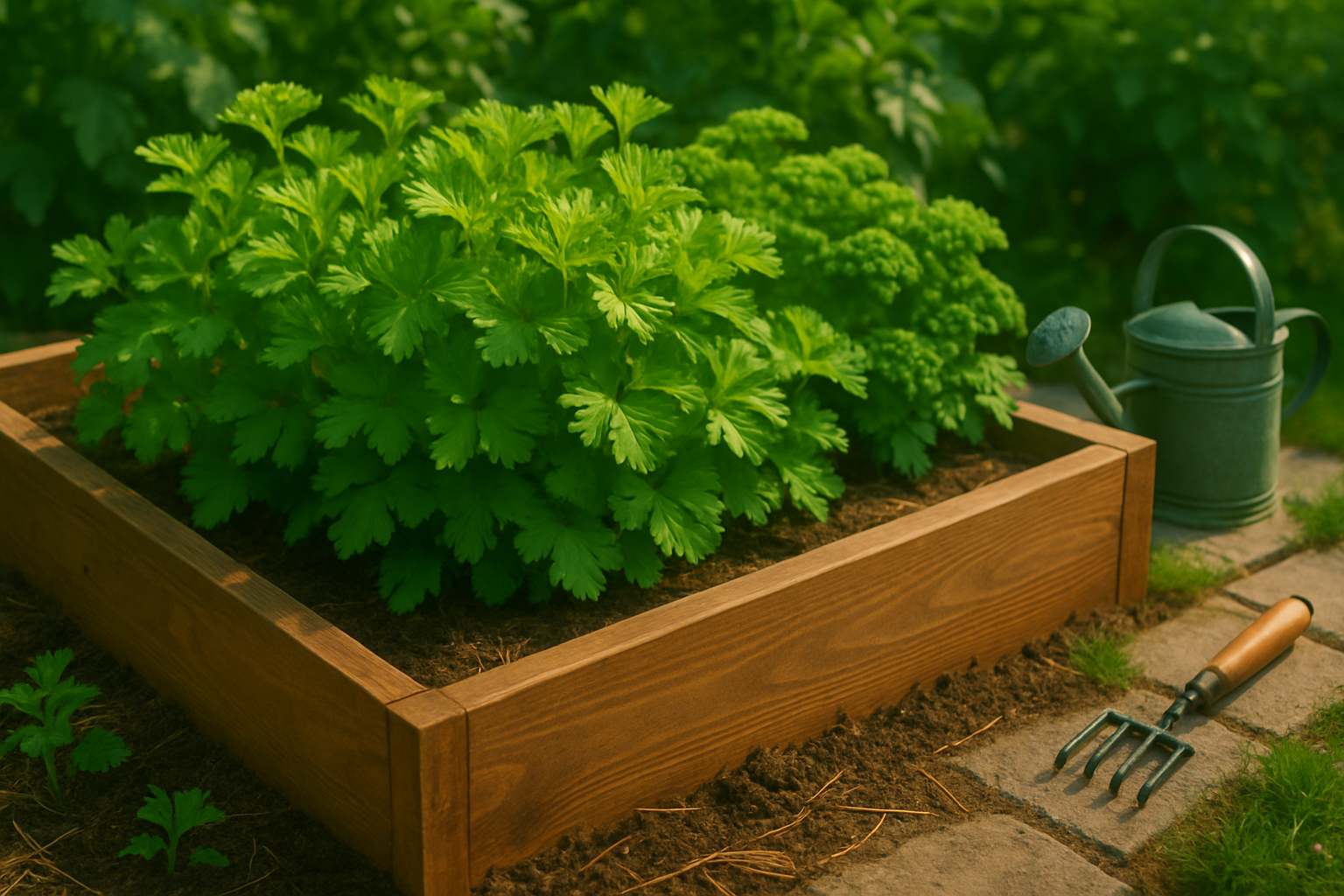Introduction to Growing Parsley in Raised Beds
Growing parsley in raised beds combines the best of flavor, convenience, and robust harvests—all in one neat package. Known for its bright, fresh taste and versatility in the kitchen, parsley isn’t just a pretty garnish; it’s also packed with vitamins A, C, and K, making it a nutritious boost for salads, soups, and much more. One of the standout features of parsley is how easy it is to grow, making it an ideal choice whether you’re just dipping your toes into gardening or already have soil under your nails.
Growing parsley in raised beds offers even more benefits than traditional in-ground planting. Raised beds provide superior drainage, minimize weed competition, and let you create the perfect soil mix, which parsley absolutely loves. They’re easier on your back, too, making tasks like watering, harvesting, and pest management more convenient. Plus, raised beds allow you to start earlier in spring and extend the growing season, giving your parsley the best environment to thrive.
In this article, we’ll guide you through everything you need to know to master growing parsley in raised beds—from selecting the best varieties to watering tips, harvesting hacks, and troubleshooting common issues. Whether you’re a beginner or a seasoned green thumb, you’ll find practical advice to make your parsley patch flourish all season long.
Choosing and Preparing Your Raised Bed
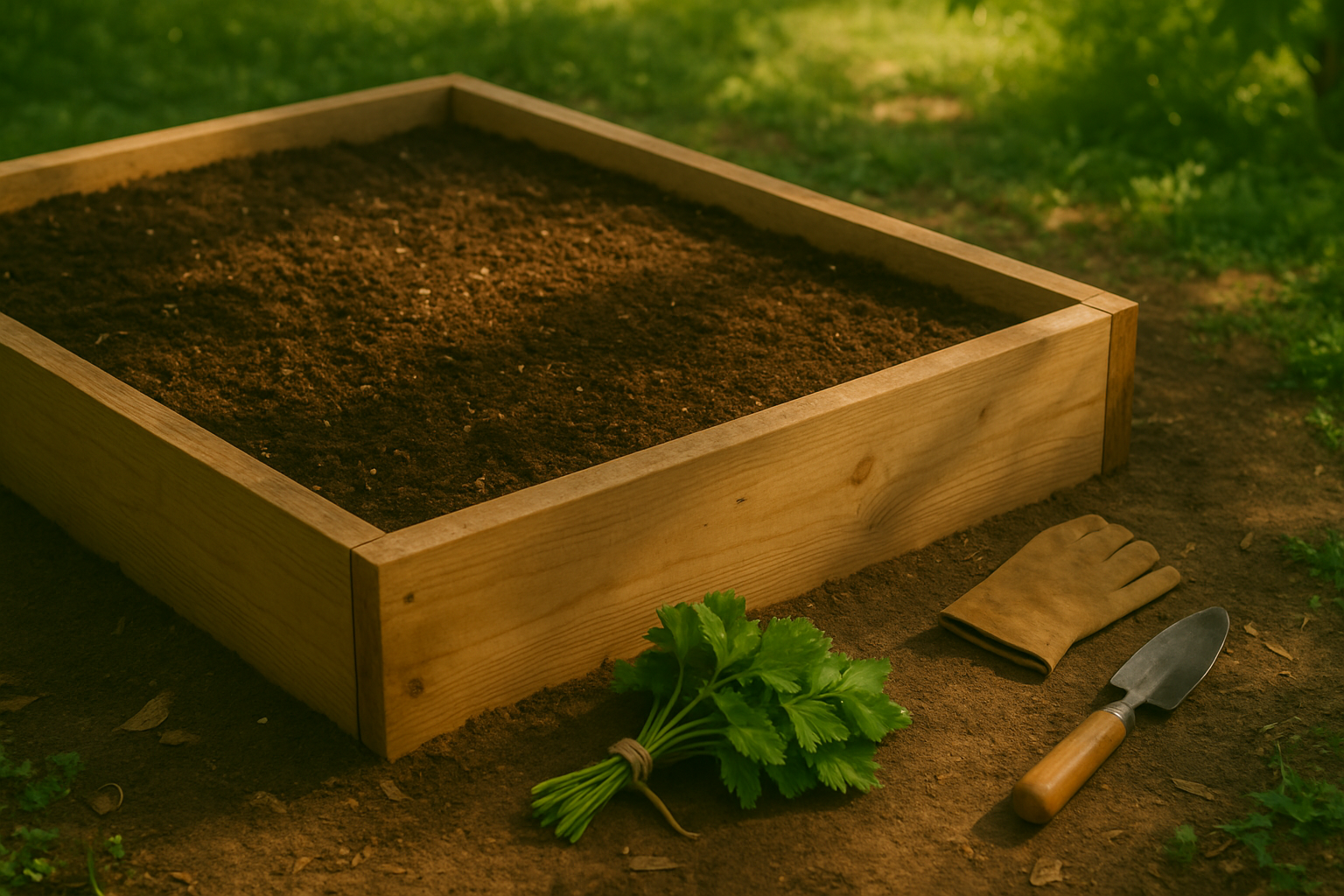
Finding the right spot for your parsley raised bed is crucial, as this herb thrives best in a sunny location with at least six hours of direct sunlight each day. Choose an area that doesn’t collect water after rain—good drainage is key since soggy roots can stunt parsley’s growth.
For bed materials, untreated cedar or redwood are excellent choices because they resist rot and don’t leach chemicals into the soil. A raised bed measuring about 3 to 4 feet wide (for easy reach across) and at least 8 to 12 inches deep provides enough space for parsley’s roots to spread and absorb nutrients.
Before planting, clear out any weeds or grass from your chosen site to prevent unwanted competition for nutrients. Loosen the soil at the base of the bed to promote drainage, then fill the frame with a mix of quality garden soil and compost or well-rotted manure, aiming for a rich, crumbly texture. Mix in organic matter thoroughly to boost fertility and moisture retention; a good rule of thumb is one part compost to two parts soil.
Level the surface, water lightly to settle the mix, and check for any remaining stones or debris. Now your raised bed is ready for sowing parsley seeds or transplanting seedlings, setting the stage for a strong, healthy harvest.
Selecting and Sowing Parsley Seeds
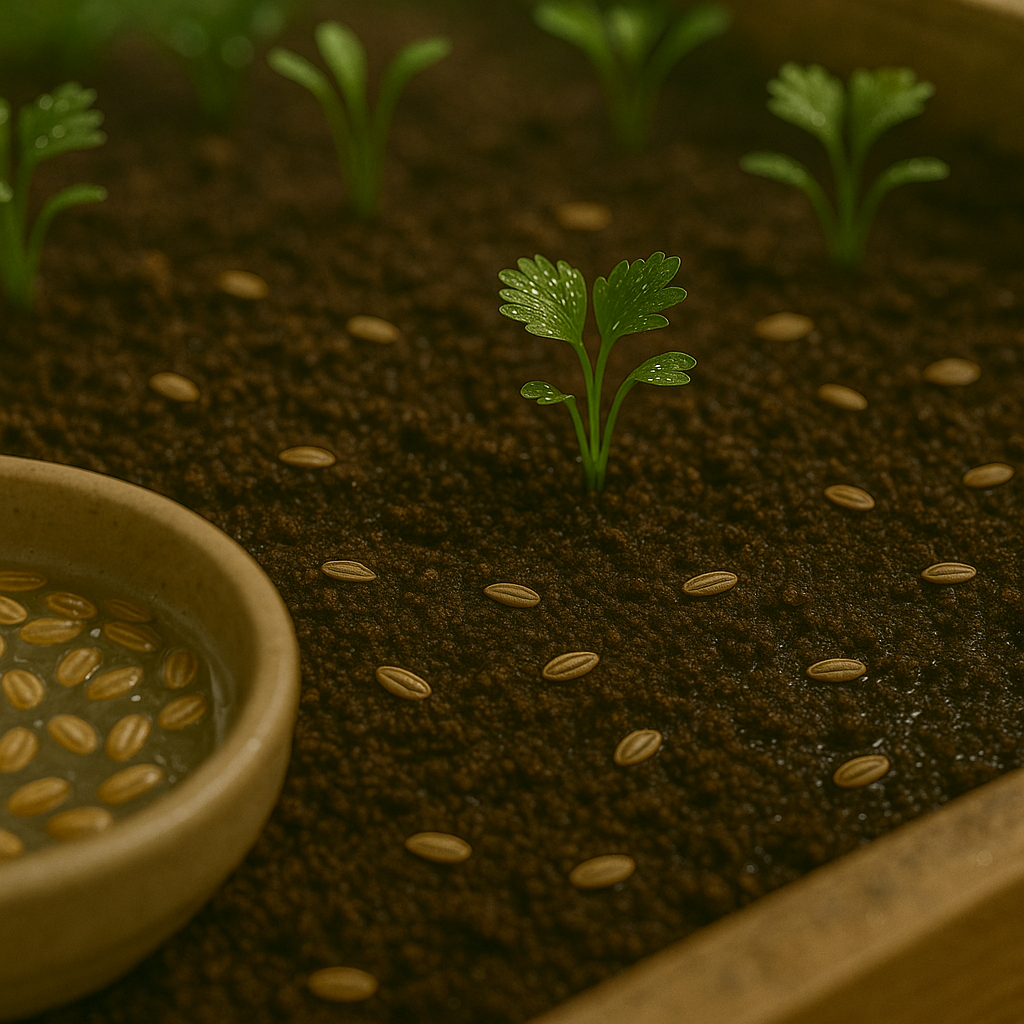
When it comes to growing parsley, you’ll usually choose between curly parsley and flat-leaf (Italian) parsley. Curly parsley is the classic garnish with tightly ruffled leaves and a milder flavor, making it great for salads and decorative platters. Flat-leaf parsley, on the other hand, has broader leaves with a bolder taste, preferred by many cooks for its rich flavor in dishes.
While both types thrive in full sun to partial shade and require similar care, flat-leaf parsley tends to grow taller and withstand heat a bit better, while curly varieties can handle cooler, damp spots in the garden. When selecting seeds, look for fresh stock from a reputable supplier to ensure high germination rates.
Parsley seeds have a notoriously hard outer shell, so soak them in warm water for 12–24 hours before planting—this helps speed up germination. The best time to sow parsley is in early spring, about 3–4 weeks before the last expected frost, or in late summer for a fall crop.
To sow, plant seeds about ¼ inch deep in well-moistened, fertile soil, spacing them 6–8 inches apart to give the leafy plants enough room to spread. Cover seeds lightly with soil and gently press down to ensure good contact. Because parsley can be slow to sprout—sometimes taking up to three weeks—keep the soil consistently damp but not waterlogged.
To guarantee a steady supply of fresh leaves, practice succession planting: sow a batch every three to four weeks throughout the season. This way, as older plants begin to slow down or bolt, new parsley will always be coming up, giving you a continuous harvest for salads, soups, and garnishes all season long.
Caring for Parsley Plants in Raised Beds
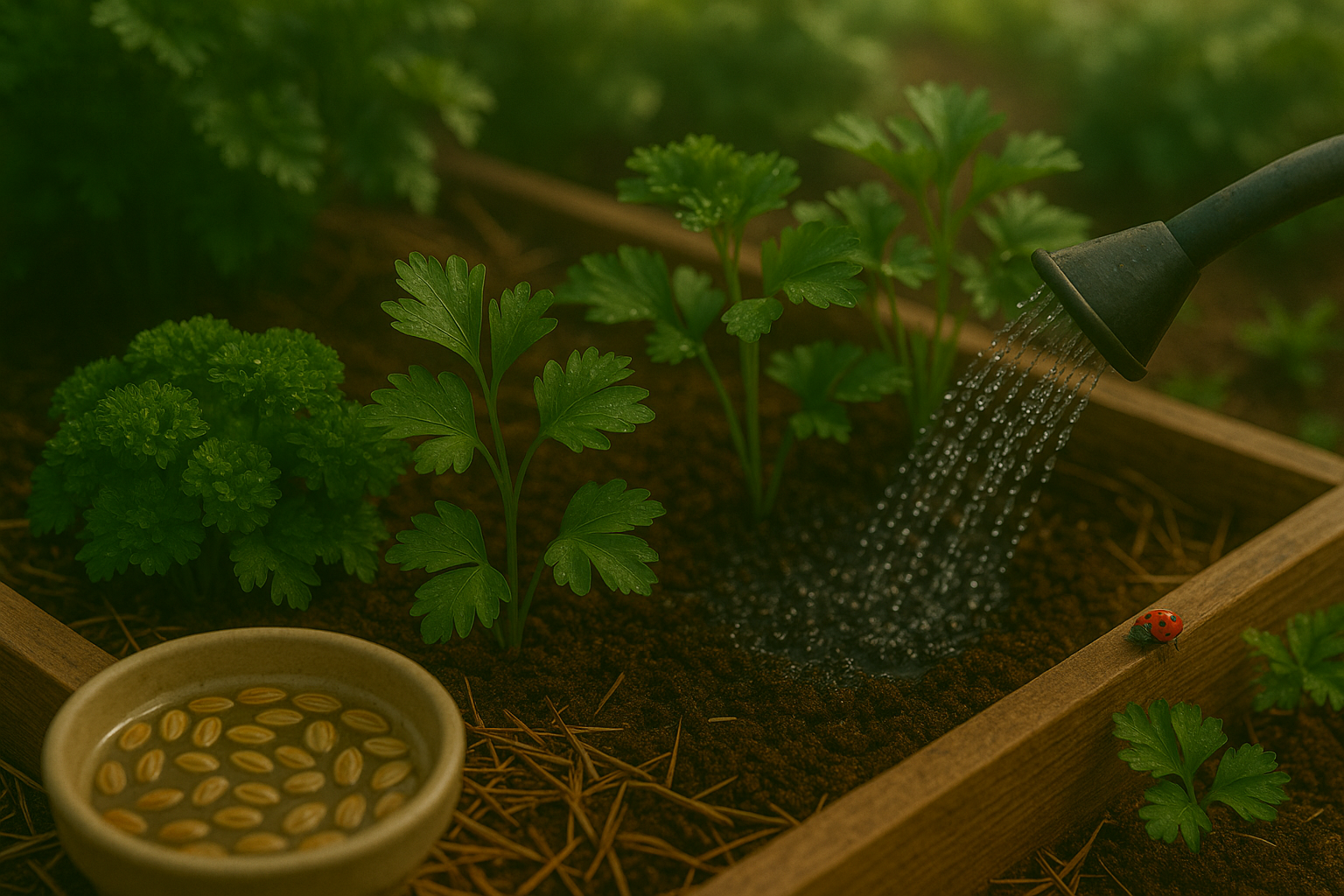
Parsley thrives in raised beds when you keep its soil consistently moist but not soggy. Water deeply when the top inch of soil feels dry, ideally in the morning, so the foliage can dry off and prevent disease. Since raised beds tend to drain faster, check moisture often—especially during warm or windy weather—but avoid overwatering, as waterlogged roots can quickly lead to root rot.
Adding a 1–2 inch layer of mulch, like straw or shredded bark, helps the soil retain moisture, suppress weeds, and keep roots cooler throughout the season. Because soil in raised beds can lose nutrients faster, feed parsley every 4–6 weeks with a balanced, organic fertilizer or a fish emulsion solution. Be careful not to overdo it; too much nitrogen encourages lush leaves at the expense of flavor and can make plants more vulnerable to pests.
Weed Control
Regular hand-pulling is best for weed control since parsley has shallow roots that you don’t want to disturb. Mulch also helps by blocking sunlight and starving weeds.
Signs of Trouble
Watch for yellowing leaves, which often signal too much moisture, poor drainage, or overcrowding. Fix these issues by spacing plants better, improving soil texture with compost, or cutting back on watering.
Pest Management
- Aphids: These pests gather on stems and the undersides of leaves. Rinse them off with a blast of water or introduce friendly predators like ladybugs.
- Caterpillars: Especially swallowtail butterfly larvae, which can chew leaves but rarely kill healthy plants. Hand-pick them or use row covers if numbers soar.
Disease Prevention
Fungal diseases like powdery mildew may appear in crowded, damp conditions. Boost airflow by thinning seedlings, avoid wetting leaves when watering, and promptly remove infected foliage.
With regular, gentle care, your parsley will stay lush, healthy, and ready for harvest right from your raised bed.
Harvesting and Maintaining Parsley
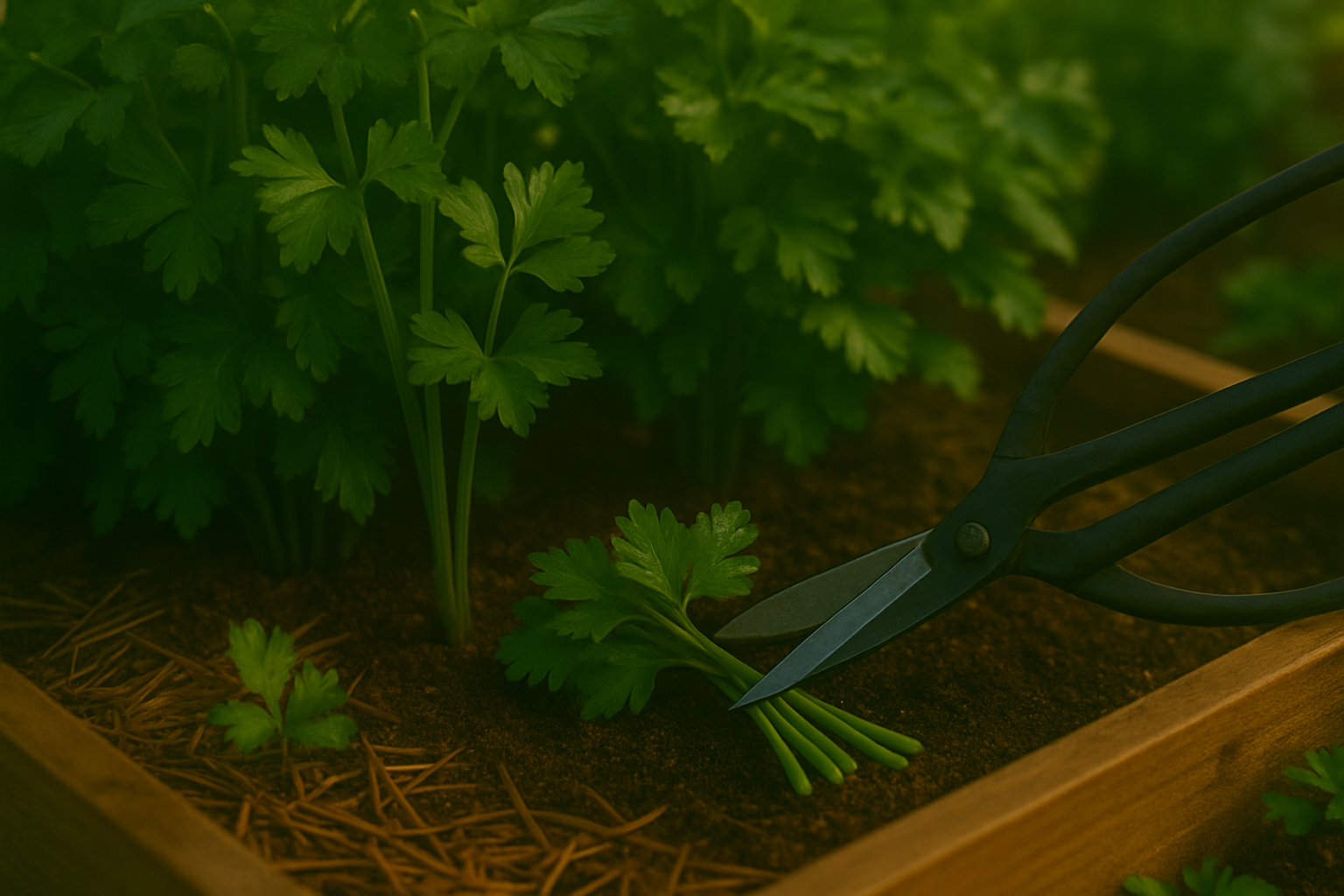
Harvesting parsley at the right time is key to enjoying its freshest flavor. For the best taste, pick parsley in the morning after the dew dries but before the midday sun, as this is when the essential oils are most concentrated.
Begin harvesting once the plant has at least three sturdy stems. Use sharp scissors or garden shears to cut the outer stems just above the soil line, leaving the inner shoots to mature and grow back quickly—this encourages bushier plants and prevents stunted growth.
Always avoid taking more than one-third of the plant at once; removing too much can stress the plant and slow down regrowth. For a constant supply, harvest regularly every few weeks, and be gentle to avoid damaging the base.
To keep your parsley healthy, remove spent stems and any yellowing or dead leaves to improve air circulation and reduce the risk of disease. Mulching around your plants can help retain moisture and keep weeds at bay, but be sure not to let mulch touch the stems directly.
Parsley also likes a steady supply of water, especially in warmer weather, so check soil moisture regularly and water early in the day when needed. By following these tips, you’ll not only extend the harvesting season but also enjoy lush, flavor-packed parsley for months.
Overwintering and Successive Planting Tips
Protecting parsley during the colder months is easier than many gardeners expect. Start by applying a thick layer of mulch, such as straw or shredded leaves, around the base of the plants in the fall. This simple step insulates the roots from freezing temperatures and helps the soil retain moisture.
In regions with harsh winters, drape frost cloths or row covers over your parsley on especially cold nights, making sure the fabric doesn’t touch the leaves directly to avoid frost damage.
For a steady harvest year-round, practice successive planting by sowing new seeds every three to four weeks, either directly in the garden or in containers that can be moved indoors. If space allows, start new transplants in late summer so they’re established before winter arrives.
In milder climates, parsley can often survive outside with just a bit of mulching, while gardeners in colder zones may want to bring potted plants inside or place them in a cold frame.
Remember, timing is key—monitor local frost dates and sow your seeds or transplants early enough to ensure strong growth before winter sets in. With a little planning, you’ll enjoy fresh parsley from your garden even when snow is on the ground.
“`html
Common Questions About Growing Parsley in Raised Beds
Growing parsley in raised beds is a smart way to boost flavor in your kitchen, and it often raises a few common questions. Many gardeners wonder about the best companion plants for parsley. You’ll have great success planting it alongside tomatoes, carrots, and chives, as these combinations can deter common pests and enhance growth.
If you’re planning how much parsley to grow, a good rule of thumb is to plant two to three parsley plants per person in your household—this usually provides enough for both fresh use and a bit of storage.
Some folks debate between raised beds and pots for parsley. Raised beds offer better drainage, deeper root room, and easier weed management, though parsley can still thrive in pots if space is tight.
If your parsley is looking sparse or leggy, a few simple tweaks can help:
- Try snipping leaves generously, as regular harvesting encourages bushier growth.
- Remember that parsley prefers consistently moist soil and partial sun.
- Mulch can help keep moisture levels even.
- A monthly feeding with diluted liquid fertilizer can stimulate lush foliage.
With these tips, even beginners can enjoy a continuous supply of vibrant, healthy parsley all season long.
“`
